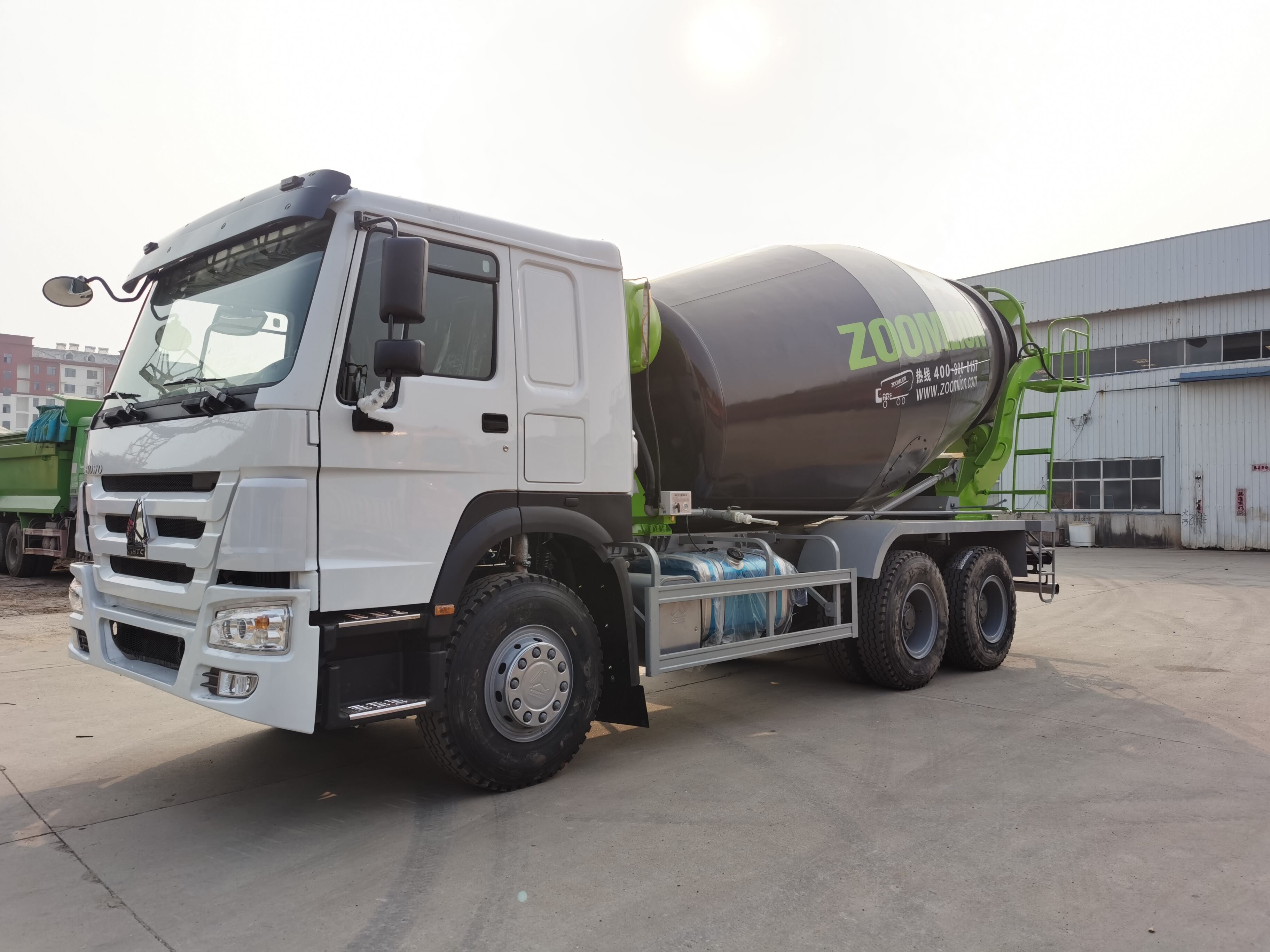How Concrete Mixer Trucks Maintain Mix Consistency During Transit
The Hydration Process and Why Concrete Begins Setting When Mixed With Water
When water meets cement, hydration starts right away, triggering chemical reactions that create those strong crystalline bonds in concrete. But there's a catch here. The National Ready Mixed Concrete Association actually sets a pretty tight 90 minute clock on how long the mix stays workable. If the truck stops moving or mixing stops for too long, some parts start hydrating before others. This leads to patchy curing throughout the batch and creates weak spots in the final structure. That's why keeping things mixed up constantly while transporting remains so important to stop the concrete from setting too early before it even reaches the job site.
Role of the Rotating Drum in Preventing Premature Setting and Segregation
Inside the mixer drum, those spiral blades work together with a controlled spin rate around 8 to 12 RPM to fight against gravity pulling aggregates apart. The drum lifts and spreads out the mix somewhere between 150 and 200 times every hour, keeping everything suspended so sand doesn't sink to the bottom while cement paste stays mixed in properly. Without this constant movement, the ingredients would separate, leading to uneven distribution throughout the concrete. That kind of segregation can really weaken the finished product's strength and durability over time.
Continuous Mixing Action and Its Impact on Uniformity and Workability
Constant blending ensures even distribution of admixtures such as plasticizers and air-entraining agents. Research indicates that continuous mixing reduces slump variation by up to 40% compared to intermittent methods, significantly improving workability and the ability of concrete to fill formwork completely without voids.
Real-Time Monitoring and On-the-Go Adjustments to the Concrete Mix
These days, most mixer trucks come with built-in sensors that keep track of things like concrete slump, temperature changes, and how fast the mix is hydrating while still on the road. When readings go beyond about plus or minus 5% of what they should be, drivers get warnings on their dashboards. They can then tweak the mixture during transport if needed, usually by adding either water or special delaying chemicals, all within those industry standard ASTM C94 guidelines. Construction companies report seeing around a 28 percent drop in wasted concrete batches since adopting this technology for big projects. Makes sense really, because catching problems early saves both time and money down the line.
Mixing Drum Design and Operational Best Practices
Concrete Mixer Truck Drum Mechanics: Structure and Mixing Function
Most mixing drums are built from tough steel cylinders with those special fins inside at odd angles. When the drum spins around, these fins actually pick up the wet concrete mix and drop it down again as gravity takes over. The whole process keeps happening over and over until everything gets mixed properly. Newer models now have these curved shapes inside that help move materials better through the drum. This means cement, gravel, sand, and water all blend together much more thoroughly, even when trucks need to deliver their loads quickly on busy construction sites where time is money.
Optimizing Rotation Speed and Tilt Angle for Consistent Blending
During transit, drum rotation is maintained at 8–12 RPM—fast enough to prevent settling but slow enough to avoid segregating heavier aggregates. A forward tilt angle of 1–2 degrees optimizes internal material movement. Field tests in 2023 demonstrated that adhering to these parameters reduces rejected loads by 33% compared to uncontrolled mixing practices.
Preventing Material Segregation Through Controlled Drum Movement
Reversing the drum’s direction every 15–20 minutes helps redistribute materials that may begin to settle, keeping fine particles like cement uniformly suspended. Additionally, controlled acceleration and deceleration during starts and stops minimize the risk of separation—especially important for high-strength concrete requiring precise slump retention.
Maintaining Drum Integrity to Ensure Long-Term Performance and Mix Quality
Checking drum liners, fin edges, and weld points regularly stops wear and corrosion before they mess up mix consistency. Companies that stick to monthly checkups typically see about 18 percent lower maintenance bills each year, plus their equipment lasts around two to three extra years. Many newer machines come with automatic washout features these days. These systems clean away leftover concrete residue, making sure every batch comes out the same quality as the last one. Some operators swear by them for keeping production running smoothly without those annoying stoppages caused by buildup issues.
Loading Procedures and Batch Integration for Optimal Mixing
Loading sequence and timing: Charging the mixer for effective integration
Most concrete batching plants follow ASTM C94/C94M-22 guidelines when loading materials into their mixers. Typically around 60 to maybe 70 percent of the coarse aggregate goes in first, then comes the cement and other binding agents, followed by the fine sand-like materials, and finally water gets added last. This order helps prevent lumps from forming and makes sure everything gets spread out properly in the mixture. All these ingredients need to be put in within roughly two to three minutes while the mixing drum spins slowly at about two to four revolutions per minute. The slow rotation starts the mixing process gently so it doesn't wake up the chemical reactions too early before everything has a chance to blend together properly.
Central mix vs. transit mix plants: Differences in loading and initial mixing
Central mix plants typically fill their mixer trucks with already blended concrete around two thirds to three quarters full, relying on the trip itself just to balance out any moisture differences. On the other hand, transit mix setups work differently by loading all the ingredients separately first, then starting the mixing process while en route at roughly 12 to 14 revolutions per minute. According to research published by NRMCA last year, these central mix facilities hit about 98 percent accuracy when measuring materials, compared to around 92 percent for transit systems. But there's something else worth noting here too the transit method actually gives contractors more room to tweak things right at the job site if needed, despite being slightly less precise overall.
Best practices to prevent premature mixing during loading and transport
To minimize segregation and preserve slump life:
- Limit drum rotation to 4–6 RPM during loading
- Delay water addition until the final transport phase
- Keep ambient temperatures below 90°F (32°C) during charging
These measures reduce segregation risks by 34%, according to PCA hydration modeling (2023), and help maintain workability for up to 90 minutes.
Ensuring accurate batching and ingredient order in concrete mixer truck loading
Today's batching equipment relies on MEMS load cells that offer around 0.5% accuracy when checking mix proportions. The automated control systems work according to EN 206:2013 guidelines, feeding materials into the mixer based on their size and weight characteristics. Typically, the process starts with those 19mm aggregate pieces first, then moves on to sand, cement, and whatever SCMs are being used in the mix design. This layering approach cuts down on blade wear by about a quarter compared to older methods, while also making sure the final product has consistent strength throughout. A study published in the ACI Materials Journal back in 2021 confirmed these benefits after testing several different batching configurations across multiple concrete plants.
On-Site Quality Control and Mix Adjustments
Evaluating Concrete Consistency Before Discharge at the Job Site
Prior to discharge, contractors conduct slump tests and visual inspections to assess mix uniformity. According to ACI 117-22, over 92% of batches must meet slump tolerances of ±1 inch to ensure structural reliability. Advanced sites also use penetrometers to measure stiffness, verifying compliance with design requirements such as 3,500 PSI compressive strength.
Adding Water: Balancing Workability With Compressive Strength
While water enhances flowability, excessive addition can reduce compressive strength by up to 40%, per NIST (2023). Best practices recommend incremental additions (≤1.5 gallons per cubic yard) combined with plasticizers. A 2024 Construction Materials Report showed that superplasticizers can maintain slump for over 90 minutes without diluting the mix, preserving 98% of the intended strength.
Correcting Off-Spec Mixes With Cement, Aggregates, or Admixtures
When a mix falls outside specifications, targeted adjustments can restore quality:
- Cement restores binding capacity in weak batches
- Aggregates correct texture imbalances like oversanding
-
Viscosity modifiers address bleeding or segregation
A 2023 analysis found that 85% of off-spec mixes were successfully corrected using these methods, significantly reducing waste and delays.
Leveraging Real-Time Monitoring Systems for Precision Quality Control
IoT-enabled sensors in modern mixer trucks continuously track slump, temperature, and hydration levels. These systems alert operators to inconsistencies 20–30 minutes before discharge, enabling proactive corrections. Projects using real-time monitoring report a 30% reduction in rejected loads, ensuring compliance with ASTM C94/C94M standards and improving overall quality control.
Comparative Benefits of Central Mix and Transit Mix Operations
Central mix plants: Advantages in batching accuracy and consistency
Central mix plants are pretty good at getting the right amounts of ingredients mixed together. Automation cuts down on mistakes made by humans by around 95% when compared to doing things manually, says the National Ready Mixed Concrete Association from their 2023 report. These plants have fancy scales and sensors that check for moisture content, so they can tweak how much water goes into the mix with aggregates based on real time conditions while still hitting those ASTM C94 requirements. Because everything is so accurate, there's less wasted material and fewer times when workers have to fix problems later. That makes central mixing a great choice for big projects where precision matters most, like building foundations for skyscrapers or constructing dams where even small errors could cause major issues down the road.
Transit mix plants: Flexibility in customization during transport
In transit mix operations, mixer trucks actually change concrete mixes while they're on the road. This lets crews tweak the slump or add stuff like accelerants when pouring in cold weather conditions. According to some research from the Concrete Industry Management Program back in 2022, around three out of four contractors prefer this method for jobs needing different concrete strengths since it cuts down on those annoying return trips to the batching plant. Plus, because the mix keeps moving during transport, the concrete stays workable about 90 minutes longer than if it were just sitting there in a truck without agitation. Most construction managers I've talked to swear by this approach for complex projects where timing matters a lot.
Case study: Efficiency and quality outcomes in real-world construction projects
The $240M Green River Bridge project achieved a 23% cost reduction by combining both methods:
- Central mix for the 8,000-yd³ abutments requiring 5,000 PSI concrete
- Transit mix for on-demand delivery of 3,000 PSI concrete to 14 dispersed pier locations
Real-time slump monitoring via embedded IoT sensors helped maintain a ±0.5-inch tolerance across all batches. This hybrid approach reduced fuel consumption by 18% and improved compressive strength consistency by 15% compared to single-method workflows, as documented in the Construction Materials Journal (2023).
FAQ
What is the purpose of a concrete mixer truck's rotating drum?
The rotating drum prevents premature setting and segregation of the concrete mix by constantly agitating it, ensuring uniform consistency and preventing sedimentation during transit.
How do real-time monitoring sensors in mixer trucks work?
These sensors track parameters like concrete slump, temperature, and hydration levels. They alert operators to inconsistencies, allowing them to make adjustments to maintain mix quality before reaching the job site.
Why is continuous mixing important for concrete workability?
Continuous mixing ensures even distribution of ingredients and reduces slump variation, improving the concrete's cohesiveness and ability to fill formwork without voids.







